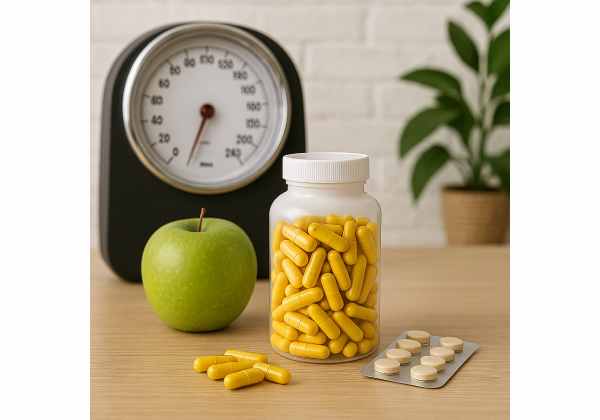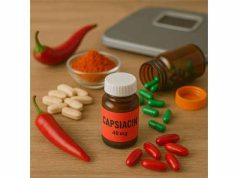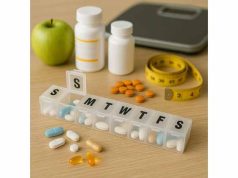
Berberine has been called “nature’s metformin” and even compared with GLP-1 medicines on social media. The truth is simpler and more useful: berberine is a plant-derived compound that can modestly improve blood sugar control, curb appetite in some people, and support small, steady fat loss—when used correctly and safely. This guide explains what results to expect, who tends to benefit, and how to take berberine without risking unsafe interactions. If you are weighing non-surgical tools alongside prescriptions, start with our overview of evidence-based medical and supplement options to see where berberine fits.
Table of Contents
- Does berberine help with weight loss?
- How berberine works in the body
- How to take berberine: dose, timing and product quality
- Common mistakes and troubleshooting
- Safety, side effects and drug interactions
- What the research actually shows
- Who should consider berberine and when to skip it
- Frequently asked questions
Does berberine help with weight loss?
Berberine is an alkaloid found in plants like Berberis (barberry) and Coptis. It has long been used for metabolic and gastrointestinal issues. In modern studies, berberine consistently shows modest effects on body weight and measurements when paired with diet changes:
- Typical expectations are 2–4% of body weight over 8–12 weeks for responders, with larger benefits in people who begin with insulin resistance, prediabetes, or type 2 diabetes.
- Waist circumference and triglycerides often fall alongside small weight changes, which matters for metabolic risk even when the scale moves slowly.
- People who are already lean, highly active, and insulin-sensitive are less likely to see measurable changes from berberine alone.
These effects are not comparable to prescription GLP-1 medicines or bariatric surgery. Berberine’s value is as a supporting tool: it can blunt appetite swings and stabilize post-meal blood sugar so you can keep portions smaller and stick to your plan.
What makes berberine different from general “fat burner” supplements is that its primary actions target glucose handling, insulin signaling, and gut hormones. That is also why it helps some people reduce cravings, especially after carb-heavy meals, and why it can be counterproductive in others (e.g., if it upsets the stomach or interacts with medications).
If you are just beginning a change in habits, anchor your plan in protein, fiber, movement, and sleep first. For a concise framework, see our guide to safe, sustainable practices in healthy weight loss basics. Berberine may then help you maintain the routine more comfortably.
How berberine works in the body
Berberine acts on several pathways that influence appetite, glucose, and fat storage. Understanding the “why” helps you use it more effectively and set realistic expectations.
1) Improves insulin sensitivity
Berberine activates AMP-activated protein kinase (AMPK)—a cellular energy sensor. AMPK activation nudges the body toward better glucose uptake in muscle and lower glucose output from the liver. Practically, that means fewer dramatic post-meal spikes and dips, which often drive cravings.
2) Eases post-meal glucose and insulin excursions
By improving insulin signaling and slowing carbohydrate absorption modestly, berberine can reduce the “rollercoaster” several hours after a carb-heavy meal. Many users notice steadier energy and less urge to snack in the afternoon or evening.
3) Favors healthier blood lipids
Berberine can lower triglycerides and LDL cholesterol in people with dyslipidemia. The changes are usually modest but meaningful when combined with diet improvements and movement.
4) Signals through the gut
Berberine interacts with the gut microbiome and may enhance secretion of GLP-1 and related gut hormones in response to meals. The downstream effect is earlier fullness for some people. This is not the same as taking a GLP-1 prescription, but it is one mechanism behind appetite changes.
5) Who feels it most
- Individuals with prediabetes, insulin resistance, or PCOS often experience clearer benefits: calmer appetite and easier portion control.
- People already eating high-protein, high-fiber meals with good glucose control may notice little or nothing.
6) How it compares with metformin
Metformin and berberine overlap in mechanisms like AMPK activation and effects on the gut. If you are curious about how prescription therapy fits into a weight plan, see our guide to metformin’s role in weight management. Never mix or swap prescriptions without your clinician’s direction.
Bottom line: berberine nudges the body toward better glucose handling and appetite regulation. That is useful—especially if cravings derail you after starch-heavy meals—but it is not a stand-alone /category/weight-loss solution.
How to take berberine: dose, timing and product quality
A simple, rinse-and-repeat routine reduces side effects and helps you judge whether berberine genuinely helps you.
Dosing that most people use
- Start with 500 mg once daily with the largest meal for 3–7 days.
- If tolerated, increase to 500 mg twice daily (breakfast and dinner).
- If needed, increase to 500 mg three times daily (with meals) for a total of 1,000–1,500 mg/day. Higher doses rarely add benefit and increase GI side effects.
Timing tips
- Take berberine with food, not on an empty stomach. This improves tolerance and targets the post-meal window when glucose handling matters most.
- If evenings are your hungriest time, make dinner one of your berberine doses.
- Give it 2–4 weeks before judging appetite effects, and 8–12 weeks for weight and waist changes.
What to combine it with (and not)
- Do: pair with 20–40 g of protein and high-fiber carbohydrates at meals. This amplifies satiety and stabilizes blood sugar.
- Do: build a consistent step count and include two to three strength sessions weekly to protect lean mass.
- Do not: add multiple “blood sugar” supplements at once. Stack changes gradually so you can tell what actually helps.
Choosing a product
- Prefer berberine HCl or a standardized extract that discloses milligrams of berberine per capsule.
- Avoid gummies or blends that hide dose per serving.
- Look for independent testing (USP, NSF, Informed Choice) to reduce contamination and mislabeling risk. If you are new to label quality, see our quick guide to reputable third-party testing.
Trial structure
- Set baselines: weight, waist, fasting glucose (if you track), and how hungry you feel two hours after two typical meals.
- Take berberine with meals as above for 8–12 weeks.
- Re-check your metrics. If appetite is unchanged and the scale is flat, there is no obligation to continue.
Storage and form
- Keep in a cool, dry place; berberine stains fabrics yellow—open capsules away from counters and clothes.
- Some prefer “phytosome” or “sustained-release” forms for GI comfort; the key is tolerability and verified dose, not marketing terms.
Common mistakes and troubleshooting
1) Taking it on an empty stomach
This increases nausea and cramping and does not improve results. Always take berberine with meals.
2) Chasing high doses
More is not better. Most data cluster around 1,000–1,500 mg/day. Going higher raises the risk of diarrhea, constipation, or abdominal pain.
3) Expecting “prescription-level” weight loss
Berberine’s role is supportive. If you need double-digit percent weight loss for health reasons, discuss medical options with your clinician (e.g., GLP-1 medicines) rather than escalating supplement doses.
4) Ignoring the basics
Appetite is easier to manage when meals include adequate protein and soluble fiber. If fullness is a challenge, consider learning about glucomannan or psyllium in our guide to fiber supplements for appetite.
5) Combining with multiple glucose-lowering agents without guidance
Mixing berberine with metformin, insulin, or sulfonylureas increases hypoglycemia risk. Coordinate with your clinician if you use any prescription that lowers glucose.
6) Quitting after three days
Give it two to four weeks for appetite effects and eight to twelve weeks for weight and waist changes. If nothing shifts by then, stop—your time and budget matter.
Troubleshooting GI symptoms
- Diarrhea or cramping: step back to the last comfortable dose, keep doses with food, and consider splitting the daily total more widely (e.g., breakfast and dinner).
- Constipation: increase fluids and fiber; keep step count up; consider magnesium if approved by your clinician.
- Nausea: shift one dose to mid-meal or try a different brand with verified content.
Safety, side effects and drug interactions
Most healthy adults tolerate berberine when used as directed, but it is not risk-free. Respect the following cautions.
Common side effects
- GI symptoms (nausea, diarrhea, constipation, gas, cramping) are dose-related and often resolve with dose reduction and meals.
- Headache or dizziness can occur early on; stop if persistent.
Who should not take berberine
- Pregnant or breastfeeding individuals: berberine can cross the placenta and enter breast milk. It also may displace bilirubin from albumin in newborns—avoid entirely during pregnancy and lactation.
- Infants and young children: do not use.
- People with significant liver disease: use only with clinician oversight and lab monitoring.
- Upcoming surgery: stop 1–2 weeks beforehand unless your surgical team advises otherwise.
High-risk interactions (talk to your clinician first)
- Glucose-lowering prescriptions: insulin, sulfonylureas, metformin, GLP-1 or SGLT2 agents—berberine may enhance effects. Monitor to avoid low blood sugar.
- Cyclosporine and tacrolimus: berberine can raise blood levels (P-gp/CYP3A4 interactions). This is critical—coordinate with your transplant/immune team.
- Certain statins, antiarrhythmics, and other CYP3A4/CYP2D6 substrates: theoretical interaction risk; medical guidance is prudent.
- Anticoagulants/antiplatelets: limited human data; use caution and clinician oversight if you take warfarin or dual antiplatelet therapy.
Allergy and sensitivity
If you develop rash, throat swelling, severe dizziness, or breathing trouble, stop and seek urgent care.
Label safety
Choose products with transparent labels and independent testing. If you are unsure how to parse labels and structure–function claims, see our primer on reading supplement labels.
Practical safety tips
- Keep to 1,000–1,500 mg/day unless your clinician directs otherwise.
- Space doses with meals; avoid bedtime if reflux or nausea are issues.
- Re-evaluate after 8–12 weeks; if no benefit, discontinue rather than “stack” products.
What the research actually shows
Study designs and limitations
Most berberine trials are small, short (8–16 weeks), and involve participants with metabolic syndrome, PCOS, prediabetes, or type 2 diabetes. Doses vary (often 500 mg two to three times daily), and many studies combine berberine with diet advice, making it hard to isolate the supplement’s independent effect.
Weight and waist changes
- Average weight loss among responders is modest—typically 2–4% of body weight over a few months.
- Waist circumference and triglycerides often improve even when the scale moves less, reflecting changes in visceral fat and post-meal metabolism.
Glucose and insulin
Participants with insulin resistance often see lower fasting glucose, better HOMA-IR, and small reductions in A1c over 8–12 weeks. Appetite feels steadier because glucose peaks and dips flatten—especially when meals contain protein and fiber.
Lipids and inflammation
Reductions in triglycerides and LDL cholesterol are common, with occasional improvements in HDL and inflammatory markers. Lifestyle changes amplify these effects.
Comparisons with medical therapy
Berberine is not a substitute for prescription medicines when those are indicated. GLP-1 treatments, for example, routinely deliver double-digit percent total body weight loss in clinical trials. If you have obesity complicated by diabetes, sleep apnea, fatty liver disease, or joint disease, review your options in our guide to GLP-1 medicines and discuss candidacy with your clinician.
Sustaining results
Like all tools, berberine works only while you take it and only alongside habits you can maintain. The strongest predictor of long-term success is not the supplement brand but follow-through on protein intake, movement, sleep, and regular check-ins with your care team.
Who should consider berberine and when to skip it
Good candidates
- Adults with overweight or obesity plus insulin resistance, prediabetes, PCOS, or elevated triglycerides who want a modest nudge to appetite and glucose control.
- People motivated to pair berberine with protein-forward meals, fiber, and regular movement.
- Those able to monitor glucose (if diabetic) and adjust medications with clinician support.
Reasonable trial plan
- Use 1,000–1,500 mg/day divided with meals for 8–12 weeks.
- Track weight, waist, hunger two hours after meals, and morning energy.
- Keep or stop based on measurable changes and tolerability.
When to skip
- Pregnancy, breastfeeding, or trying to conceive.
- Infants and children.
- Active liver disease without specialist oversight.
- Transplant recipients or those on cyclosporine/tacrolimus unless managed by the prescribing team.
- Anyone expecting GLP-1-level weight loss from a supplement—choose the right tool for the problem.
Alternatives that often outperform berberine
- Protein plus fiber first at meals (often the highest-impact “supplement”).
- Structured exercise with two to three days of strength training.
- Prescription options (e.g., GLP-1 medicines) when clinically appropriate.
- Bariatric surgery for severe obesity with complications, when you meet criteria and prefer a procedural route.
The simplest rule
If berberine calms appetite and steadies your energy without side effects or interactions, it can be worth keeping. If not, redirect effort toward the habits and therapies that are most likely to change your health trajectory.
Frequently asked questions
What dose of berberine should I take for weight loss?
Most people use 1,000–1,500 mg per day, divided as 500 mg with meals two to three times daily. Start with 500 mg once daily for several days, then increase if tolerated. Higher doses rarely add benefit and increase nausea, diarrhea, or constipation.
How long does berberine take to work?
Appetite and energy changes may appear in 2–4 weeks. For weight and waist measurements, evaluate after 8–12 weeks of consistent dosing with meals. If nothing changes by then, stop and focus on higher-impact approaches like diet structure, activity, or medical therapy.
Can I take berberine with metformin or GLP-1 medicines?
Do not combine without your clinician’s guidance. Berberine can enhance glucose-lowering, increasing the risk of hypoglycemia when used with metformin, insulin, or sulfonylureas. If your clinician allows a trial, monitor glucose closely and adjust prescriptions as directed.
Is berberine safe to take long term?
Long-term safety data are limited. If you continue beyond a few months, use the lowest effective dose, take it with meals, and check in with your clinician—especially if you have liver disease or take interacting drugs. Re-evaluate its value at regular intervals.
Who should avoid berberine completely?
Avoid during pregnancy and breastfeeding and do not give it to infants or young children. People on cyclosporine or tacrolimus, those with significant liver disease, or anyone undergoing surgery soon should not use berberine unless their medical team approves and monitors it.
Do gummies or blends work as well as capsules?
Usually not. Gummies and blends often contain low, undisclosed doses and extra sugars or sweeteners. Choose a product that lists milligrams of berberine per serving and has independent testing so you know what you are taking.
References
- Berberine and Weight Loss: What You Need To Know (2023) (Government Safety Summary)
- The effects of berberine supplementation on cardiovascular risk factors in adults: A systematic review and dose-response meta-analysis (2022) (Systematic Review)
- Berberine and health outcomes: An umbrella review (2023) (Systematic Review)
- Impact of Berberine or Berberine Combination Products on Lipoprotein, Triglyceride and Biological Safety Marker Concentrations in Patients with Hyperlipidemia: A Systematic Review and Meta-Analysis (2024) (Systematic Review)
- Tacrolimus and herbs interactions: a review (2021) (Review)
Disclaimer
This article is for educational purposes and does not replace personalized medical advice, diagnosis, or treatment. Always consult your healthcare professional before starting or stopping any supplement or medication—especially if you have diabetes, liver disease, are pregnant or breastfeeding, take interacting prescriptions, or have upcoming surgery.
Share and follow
If this guide clarified whether berberine belongs in your plan, consider sharing it with someone comparing options. For practical, evidence-based updates on weight, nutrition, and metabolic health, follow us on the social platform you use most—Facebook, X, Instagram, or LinkedIn.










